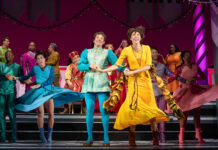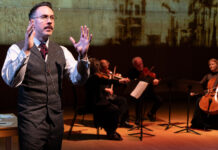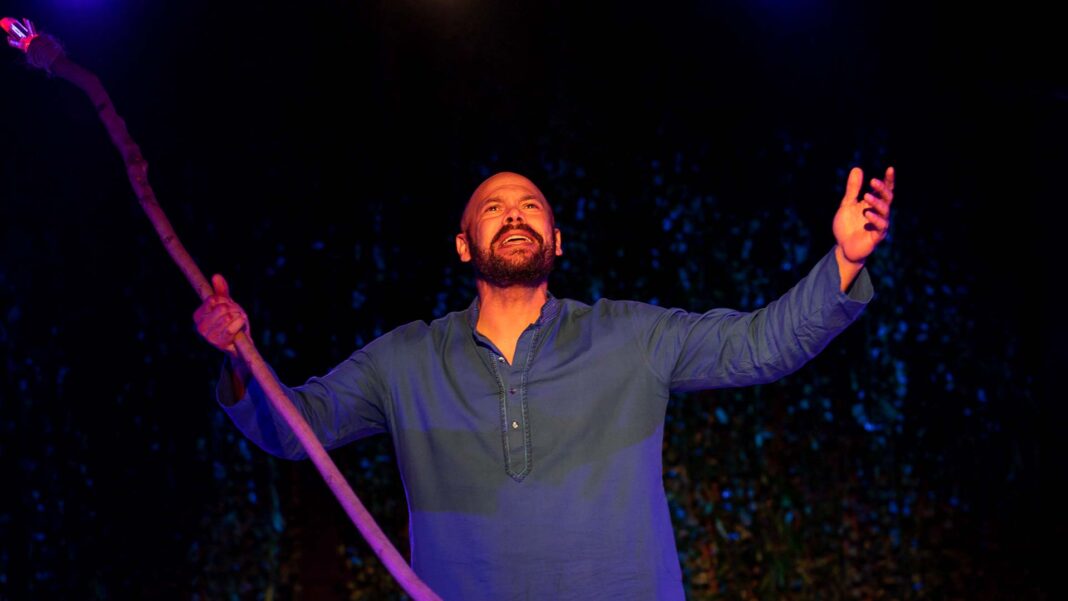For over 35 years Shakespeare Center LA has presented productions of the bard’s 37 plays. But they’ve never created an immersive theatrical event like their current production of The Tempest. Widely believed to be Shakespeare’s last play, The Tempest is certainly one of his shortest. With the idea of creating a different production for changing times, Ben Donenberg, Founder and Artistic Director of SCLA, turned to Graham Wetterhahn and After Hours Theatre Company.

After Hours has created immersive productions of One Flew Over the Cuckoo’s Nest, Jason Robert Brown‘s The Last Five Years and more. Wetterhahn and Donenberg first worked together when Al Pacino did a fundraiser for SCLA last year. A post-event dinner conversation turned to possible collaborations and the end result is The Tempest which is scheduled to run through April 16th at SCLA in downtown Los Angeles.
In the play Prospero, the former Duke of Milan, has conjured up a storm to exact revenge for his being replaced as Duke of Milan by his brother after King Alonso and his brother Sebastian engineered it. A ship carrying those who wronged Prospero is caught up in the storm conjured by the former Duke. They are shipwrecked and find themselves on an island with only Prospero, his daughter Miranda and a creature named Caliban as its occupants.
This production of The Tempest begins with the audience (split into three staggered arrival times) “boarding” the doomed ship and being introduced to many of the characters from the play. They ultimately find themselves “on” the island where a puzzle is presented by a sprite that allows those who solve it to enter Prospero’s house. Clues as to the answer to that puzzle are meant to be discovered and repeated back to the sprite.
Last week, after attending the final preview performance of The Tempest a few days earlier, I spoke with Wetterhahn about the marriage of Shakespeare and immersive theatre; creating a physical world for audiences that extends the narrative of the play and whether this production is likely to inspire new audiences to want to see other productions of Shakespeare’s plays.
What follows are excerpts from our conversation that have been edited for length and clarity.
When you’re creating not just a production of a play, but an immersive experience that extends the narrative of the play into something that’s up to an hour in length prior to the play starts, how much does the text, the language that Shakespeare uses, inspire what the totality of the experience is going to be?
First of all, what makes a good immersive piece or what makes the easiest or most distinct immersive hybrid piece is one of the main reasons we chose to do The Tempest because of its timeline and location. It takes place essentially in real time in one location, which makes it very easy to drop an audience into [it]. If you’re doing something like Hamlet or the Scottish play where there’s ten different locations in different timelines, it becomes a lot harder for an audience to track. So that I think that was a big one.
Ben Donenberg, who directed the piece, has dedicated his life to the production and study of Shakespearean text. After Hours, of course, we’re fans of Shakespeare, but this is personally the first Shakespeare piece that I worked on. We were approaching it [with] how do we make Shakespeare more accessible?
The first act there’s Antonio and Alonzo and Adrian. Trying to keep these relationships and names clear is very challenging. It’s very dense and it keeps me from engaging fully with the piece. So we’re trying to figure out how can we get audiences who aren’t trained in Shakespeare to be able to engage in a classic Shakespearean piece of text. To bring this full circle to the original question, we take a lot of inspiration from the text in order to use the characters, the relationships, the general objectives and specific phrases to try and educate the audience and get them invested in the show prior to the play beginning. So that once the play begins we’ve hopefully, in a fun way, forced you to sort of do a study guide before the show begins.
What’s the criteria you use in determining what projects are ripe for an immersive experience?
Something that has a very strong sense of location or esthetic because it’s very easy to. I don’t want to say elevator pitch a show, but it’s very easy to to sell an audience or for an audience to understand the show. You’re going to be shipwrecked onto a magical island. Previously, we’ve done One Flew Over the Cuckoo’s Nest. You’re going to be a patient in in the in the mental hospital.
I think also shows where the audience has a role within the play are good. For example, in The Tempest technically there’s two different directions we could go and we talked pretty extensively about both. One is you are a shipwrecked part of the crew or a passenger shipwrecked on the island. So there’s a natural role for you. The other would be you are a Sprite on the island. That was a little bit harder to convey narratively to the audience.

You want to introduce the audience to a lot of a lot of characters, but a lot of those characters in person. We tried doing it through puzzles and text, but it’s hard because a big part of the play is [characters who have] never seen another human before: Miranda and Caliban. So if all of the sudden you introduce Miranda to 150 people at the top of the show, it doesn’t help that throughline very well. That was definitely one of the challenges: how do you maintain the integrity of a vacant, deserted island while also battling the reality of 150 of us just washed ashore?
If you’re looking at making Shakespeare more accessible through through these intimate, immersive experiential productions is the hope that these kind of productions will replace traditional ones, or that people will get a better handle on Shakespeare and be more inspired to seek out traditional productions?
It’s definitely the latter. There’s certainly enough room for both to coexist. I’m a traditional theater fan at my core. I don’t think this is something that should or could replace traditional theater. But I do think this is a good gateway for people that maybe might not choose to see theater.
If you’ve ever been to a Sunday matinee of any regional theater you know what I’m talking about. Usually there’s not many people under the age of 65 in any of those audiences. Not that there’s anything wrong with that, but perhaps there’s a way to attract new people to theater. Based on the audience feedback from this production we have seen that this model really works for attracting new audiences and gets new people excited.
The hope is that they’d see this, get excited and then maybe that’s a gateway to seeing more traditional pieces. And vice-versa maybe for traditional theatergoers to see some more immersive style pieces.
We’ve discussed a bit about how this changes the experience for the audience. How does this change the experience for the actors?
I think they all were very excited by the challenge. We didn’t really have any issues with anybody, but I think a lot of them also found it to be very interesting and exciting. For a lot of performers who like to spend some time getting into the proper actor headspace, getting an hour before the show starts to build rapport with your audience and to embody the character I think is really helpful. It’s not for everybody, but for the actors that choose to audition for a piece like this kind of know what they’re getting themselves into. I think they’ve all really enjoyed that process.
Is there a price to be paid by encouraging people to drink, encouraging people to play puzzles and things like that before they see a show? As you know, the performance I attended had several challenges with audience members using their phones, making out and talking rather loudly.
I will say the Thursday that you came was one of our rowdiest audiences we’ve had. That, I would say, was more of an exception to the rule than the norm. But there’s still definitely much more of that than in a traditional theater. So then it goes back to is that something that needs to be clarified? We have to get our pre-show rules and regulations and expectations set a little bit better. Part of this is people having never been to theater and not fully understanding etiquette. Part of this is, perhaps, people thinking they’re just going to a cocktail experience and don’t fully understand that they’re going to see a full piece of Shakespeare.
We want the actors to be respected. We want the house staff to be respected. We want the audiences to enjoy the show. And we also don’t want other audiences to be distracted by these people. I think it will continue to improve over the course of the run.
My guest felt like the interactive component felt like an escape room to him. How much of an influence is the escape room concept for what you are trying to accomplish here?

I think that’s an astute perspective. So there’s a bunch of different types of these pre-show immersive. If you look at the ship design, for example, the ship sequence is you’re getting quickly introduced to a bunch of characters. There’s not any puzzle or anything like that on the ship, but that’s more of an actor-driven experience. Whereas once we’re on the island it’s a non-actor-driven experience. It was definitely very inspired by puzzle design. We had a number of our friends who are escape room creators come and see it and give notes on the piece.
One of the biggest challenges that an escape room designer doesn’t normally face is a typical immersive piece does not have 150 audience members simultaneously in a night. That is a unique challenge to trying to hybridize these styles.
There was a question that was asked one of the creators of Sleep No More (New York’s follow-the-characters around various rooms version of Macbeth) when that project first opened. How do you balance the concept or design of a community event with the experience each individual will have when they see The Tempest?
The reason I love theater is because of that energy exchange between the audience and performance. The reason I love intimate and immersive theater is because that energy exchange between audience and performance is put on steroids a little. I think the goal with this hybrid style is to enable that audience to feel an individual connection with characters in the show, while also creating that communal experience of sitting in an audience and watching an excellent show. One of the things that attracts me to theater and to creating theater is that shared communal experience and I assume for most other theater lovers as well. We’re trying to do something where you can develop a personal relationship with the show, but you still have the communal experience of watching a show.
Photo: Chris Butler as Prospero in Shakespeare Center LA’s production of The Tempest (Photo by Brian Hashimoto/Courtesy SCLA)










